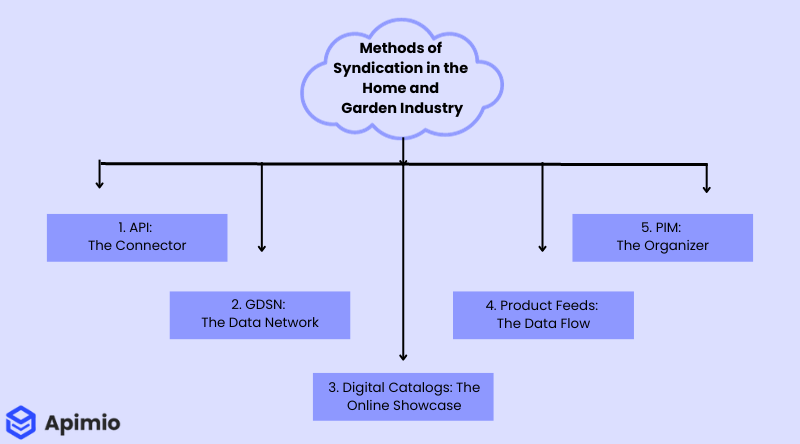Key Takeaways
- Consistent product info across platforms establishes trust and boosts your brand’s credibility.
- Go beyond listings—360-degree spins, videos, and virtual tours create lasting impressions and captivate your audience.
- Syndication methods like API and product feeds adapt seamlessly, showcasing your expanding product range swiftly and accurately.
- PIM goes beyond management, reducing errors and ensuring a smooth data flow from creation to syndication.
- Choose Apimio PIM for seamless distribution, harmonious data management, and future-proofing your brand in the digital landscape.
Have you ever wondered how your home and garden products can stand out in the digital world? What if your item setup could not only meet but exceed shopper expectations?
As the online marketplace becomes increasingly competitive, delivering compelling and seamless experiences for shoppers is more critical than ever.
The key to overcoming these challenges lies in adopting innovative solutions, and one such innovative solution is Product Information Management (PIM).
What is the importance of Accurate Item Setup?
Accuracy isn’t a formality; it’s a gateway to creating memorable, satisfying experiences.
Let’s say a customer, envisioning a vibrant garden, encounters your collection of flower pots.
Accurate item setup means they not only see the vivid images but also watch a brief video showcasing the pots in various garden settings—blooms flourishing, colors popping.
It’s not just about selling a product; it’s about selling the dream of a flourishing garden at their fingertips.
Why Does Item Setup Matter?

1. Empowers Choices
Shoppers crave details. Accurate item setup isn’t just about stating dimensions; it’s about empowering customers to make informed choices.
Imagine a customer confidently selecting the perfect planter because they know it’s not just a pot; it’s a charming addition that fits seamlessly into their living space.
2. Visual Storytelling
Installation and use case videos bring products to life. Consider a home decor enthusiast noticing your stylish shelving unit.
With a captivating video, they see its aesthetic appeal and visualize how it elegantly organizes their space. It’s not just a purchase; it’s an addition to their lifestyle.
Elevate your brand’s digital presence with Apimio PIM
Book a demo with Apimio Experts and experience seamless product syndication

3. Trust in Precision
Dimensions matter. Picture a customer measuring their balcony for a new set of chairs.
Accurate dimension information ensures a perfect fit, eliminating guesswork and fostering trust. It’s not just a transaction; it’s a hassle-free, confidence-building experience.
How do PIM and Syndication work for Digital Shelf?
Picture this scenario: A customer falls in love with your sleek outdoor grill on your website.
Now, imagine that same customer encountering a different product description on a third-party marketplace.
Confusing, right? Here’s where syndication and PIM step in as the guardians of consistency.

Syndication ensures everyone sees the same, consistent information, no matter where they find you.
PIM takes all your product details, keeps them in one neat place, and makes sure they’re ready to shine online.
PIM ensures your product data is organized, updated in real-time, and ready to dazzle on any digital shelf.
Methods of Syndication in the Home and Garden Industry
In the home and garden industry, getting your products on different online platforms is like sending out invitations to a garden party. How do you do it?

Let’s talk about the effective ways—API, GDSN, digital catalogs, product feeds, and PIM.
1. API: The Connector
API (Application Programming Interface) is like a connector that seamlessly links your product info from your system to other websites.
It’s like magic; your data travels instantly.
2. GDSN: The Data Network
GDSN (Global Data Synchronization Network) is like a superhighway for product data.
It’s a network that makes sure your info flows smoothly between you and retailers.
3. Digital Catalogs: The Online Showcase
Digital catalogs are like online brochures showcasing your products.
They make your items look irresistible, just like a catalog you’d flip through at your favorite store.
4. Product Feeds: The Data Flow
Product feeds are like data streams that deliver your product info to different platforms.
It’s the flow that keeps your online presence fresh and vibrant.
5. PIM: The Organizer
PIM ensures your product info, no matter where it’s going, follows the same rules.
It’s like having a language everyone understands, ensuring your online garden party is harmonious and consistent.
Transform your organizational efficiency with Apimio PIM
Discover how Apimio reduces errors and ensures a seamless flow of data
Best Practices for Syndicating Item Setup with PIM
In the world of home and garden, it’s not just about being present; it’s about being the star of the show.

Let’s discuss some best practices that you can follow to make your products shine.
1. Craft Content for Each Platform
Imagine telling a story. Now imagine telling it differently to your friends, family, and coworkers.
That’s what channel-specific content optimization is about—telling your product story in a way that captivates each audience on every platform.
Why It Matters: Customers on different platforms have different interests. With tailored content, you’re not just present; you’re present in a way that speaks directly to them.
2. Empower Your Team with PIM
Think of your team as superheroes and give them the right tools.
Oversight-dependent team access with PIM is like giving them capes—empowering them with access to the latest product info while ensuring they oversee everything.
Why It Matters: Your IT, marketing, and sales teams each have a role to play. Give them the power to shine in their roles, ensuring your products hit the online stage faster and with flair.
3. Make Your Products Come Alive
It’s not just about showing your product; it’s about letting customers experience it.
Create dynamic experiences with PIM—imagine 360-degree spins, videos, and virtual tours.
It’s like inviting customers to a front-row seat at your product showcase.
Why It Matters: In a digital world, static images are like yesterday’s news. Dynamic experiences are the headlines, making your products unforgettable.
4. Structure the Data and Rich Snippets
Imagine Google as a friend who loves organized information.
Structured data is like speaking its language—clear, organized, and straight to the point.
Add rich snippets, and you’re turning your product data into a conversation starter.
Why It Matters: When Google understands you, it helps your products be more visible. Structured data and rich snippets are your secret codes to be seen and heard.
5. Let Your Customers Be Your Storytellers
Reviews are like stories told by your customers. They build trust and give your brand a personality.
Encourage user reviews and ratings, and suddenly, it’s not just you talking about your product; it’s everyone who loves it.
Why It Matters: In a world full of choices, trust is the currency. User reviews are your customers shouting, “This is amazing!”—and that’s a story everyone wants to hear.
6. Continuously Improve with PIM
Think of your product information as a gem.
Continuously improve product experiences by analyzing what makes it sparkle and adapting it for each stage.
It’s like polishing that gem, ensuring it catches the eye every time.
Why It Matters: The digital world evolves fast. By continuously improving, you stay ahead, making sure your products are not just seen but also converted.
Choose Apimio PIM for Item Setup Syndication
In the crowded digital marketplace, Apimio PIM stands out as the ultimate solution for syndicating your item setup.
Imagine your product details effortlessly flowing across various online platforms—seamless data by Apimio PIM.
What sets us apart? Harmony. We ensure your product information remains the same and consistent across all online channels, lasting a memorable impression on your audience.
As your product catalog expands, Apimio PIM seamlessly scales with you, providing a robust foundation for your brand’s growth in the ever-evolving digital landscape.
Elevate your products, ensure consistency, empower your team, and future-proof your brand with Apimio PIM.
Conclusion
The digital shelf is not just a space; it’s a stage where home and garden brands have the opportunity to captivate, convert, and leave a lasting impression.
By implementing the best practices and embracing the diverse methods of syndication, brands can ensure their digital presence is not just seen but celebrated—a symphony of success in the ever-evolving digital landscape.
What to do Next?
- Sign up now for Apimio’s powerful PIM software and streamline your product data management effortlessly.
- Dive into the world of e-commerce excellence – read our blogs for valuable insights.
- Head on to Home and Garden Brands-related blogs to get more information.
- Need assistance? Reach out to our dedicated customer support team and unlock the full potential of Apimio PIM.
Frequently Asked Questions
PIM acts as the conductor of a harmonious presentation of product data. It ensures consistency across various platforms, empowers teams with streamlined access, and future-proofs brands for growth.
Consistency ensures that product information remains uniform across different platforms, providing a seamless and trustworthy experience for customers.
Syndication is distributing product content, like descriptions and images, across various online platforms to ensure a consistent brand presence.
Methods include API (Application Program Interface), GDSN (Global Data Synchronization Network), digital catalogs, and product feeds, each playing a unique role in reaching audiences.



